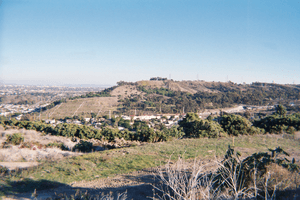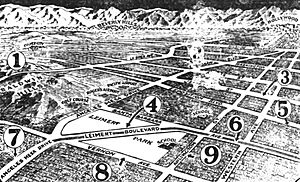Baldwin Hills (mountain range) facts for kids
Quick facts for kids Baldwin Hills |
|
|---|---|
| Highest point | |
| Elevation | 156 m (512 ft) |
| Geography | |
| Country | United States |
| State | California |
| District | Los Angeles County |
| Range coordinates | 33°59′43″N 118°21′50″W / 33.99528°N 118.36389°W |
| Topo map | USGS Inglewood |
The Baldwin Hills are a low mountain range surrounded by and rising above the Los Angeles Basin plain in central Los Angeles County, California. The Pacific Ocean is to the west, the Santa Monica Mountains to the north, Downtown Los Angeles to the northeast, and the Palos Verdes Hills to the south - with all easily viewed from the Baldwin Hills.
Geography
The headwaters of the urban river known as Ballona Creek are in the Santa Monica Mountains, such as above Beverly Hills and flows along the north base of Baldwin Hills through an active geological watergap, on the way to the Pacific Ocean in Santa Monica Bay. La Cienega Boulevard goes through a pass in the ridge of the Baldwin Hills between Inglewood and Culver City, and northeast of Los Angeles International Airport. La Cienega Boulevard is a parkway road passing alongside open space of large private corporate lands with oil wells of the Inglewood Oil Field in the southern Baldwin Hills.


History
- Rancho La Cienega o Paso de la Tijera - eastern area
- Sanchez Adobe de Rancho La Cienega o Paso de la Tijera. The adobe was once the center of the rancho. In the 1920s, an addition was built linking the structures and the building was converted into a larger clubhouse for the Sunset Golf Course.
- Rancho Rincon de los Bueyes - western area
- The hills are the location of the Baldwin Hills Dam failure and subsequent 1963 Baldwin Hills Reservoir flooding disaster.
Recreation
- Kenneth Hahn State Recreation Area - recreation, such as walking, picnicking, and birdwatching fits in with preservation of the open-space lands and native habitats: entrance on South La Cienega Boulevard.
Images for kids



